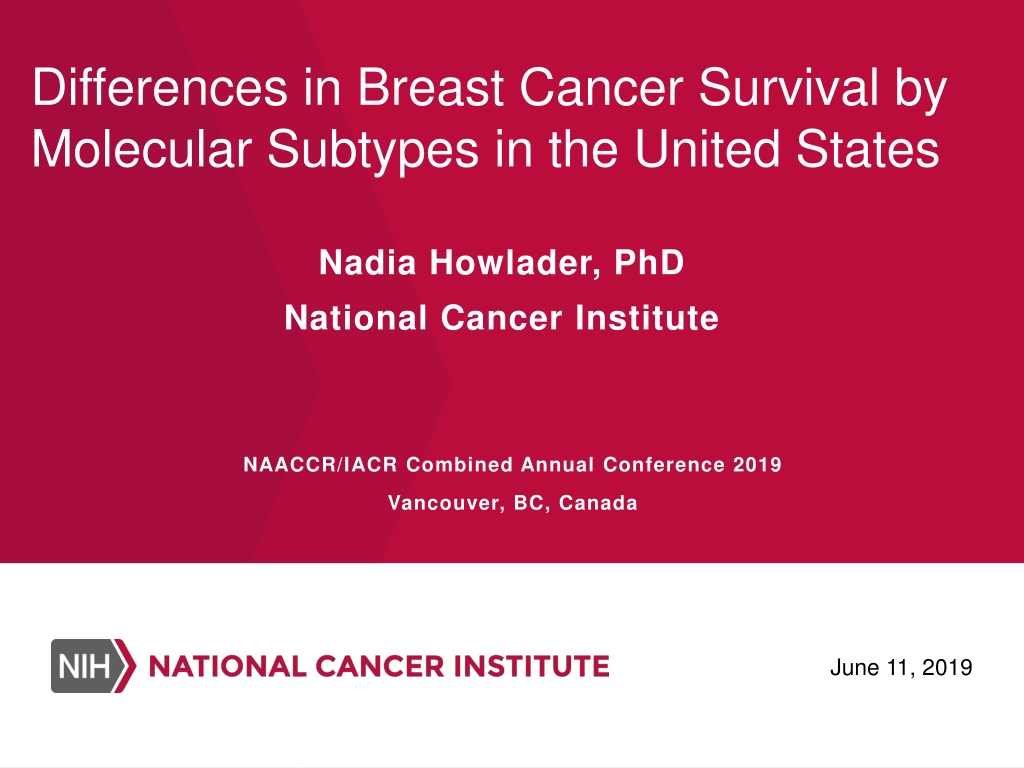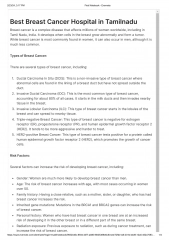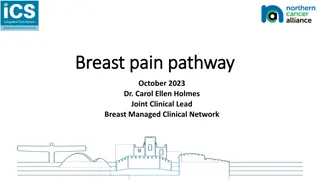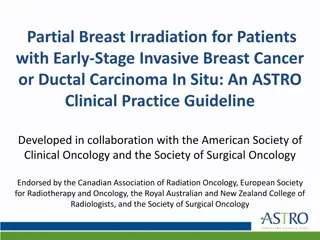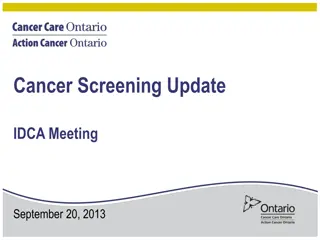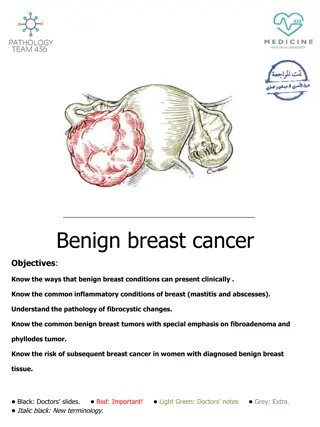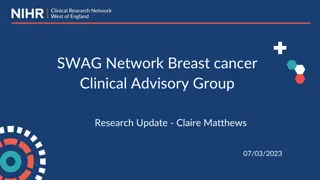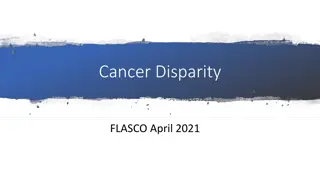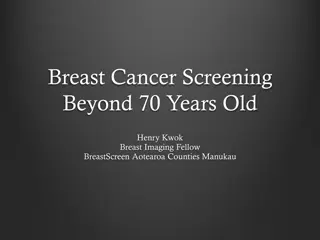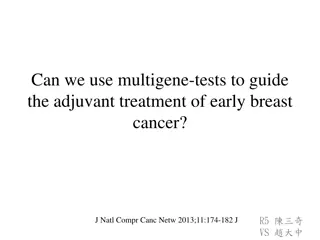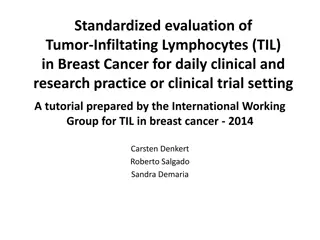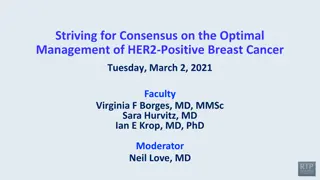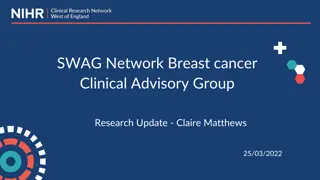Breast Cancer Survival Disparities by Molecular Subtypes in the US
Breast cancer molecular subtypes play a crucial role in determining survival outcomes. This study by Nadia Howlader, PhD, from the National Cancer Institute, presented the first nationally representative estimates of breast cancer survival by four main molecular subtypes. The research aimed to understand the impact of these subtypes on survival and develop methods to improve accuracy in survival estimates. By analyzing data from 2010-2013, the study provided valuable insights into the association between molecular subtypes and breast cancer outcomes in the US population.
Download Presentation

Please find below an Image/Link to download the presentation.
The content on the website is provided AS IS for your information and personal use only. It may not be sold, licensed, or shared on other websites without obtaining consent from the author. Download presentation by click this link. If you encounter any issues during the download, it is possible that the publisher has removed the file from their server.
E N D
Presentation Transcript
Differences in Breast Cancer Survival by Molecular Subtypes in the United States Nadia Howlader, PhD National Cancer Institute NAACCR/IACR Combined Annual Conference 2019 Vancouver, BC, Canada June 11, 2019
Background Breast cancer molecular subtypes have been defined based on gene expression profiling The major subtypes of breast cancer are approximated by the joint expression of three tumor markers: estrogen receptor (ER), progesterone receptor (PR) [where ER and PR status are jointly assessed as hormone receptor (HR) status], and human epidermal growth factor receptor 2 (HER2) status The four main molecular subtypes approximated by joint HR/HER2 status: HR+/HER2 (i.e., approximating Luminal A subtype), HR+/HER2+ (Luminal B), HR /HER2+(HER2-enriched), and HR /HER2 (triple-negative) 2
Background While incidence rates of breast cancer molecular subtypes in the US are well documented1 Effects of molecular subtypes on breast cancer specific survival using the largest population coverage to date are unknown in the U.S. population 1 Howlader et al. JNCI 2014; Kohler et al. JNCI 2015 3
Study Aims First aim was to present the first report of nationally representative breast cancer specific survival estimates by four main molecular subtypes assessment of outcomes by subtypes after controlling for demographic/clinical features Our second aim was to develop an imputation algorithm to fill in missing receptor status enabling us to obtain accurate estimates of breast cancer survival in the population 4
Methods Females with invasive breast cancer cases diagnosed during 2010- 2013 and followed until December 31, 2014 SEER-18 (covering about 28% of the US population) We begun analysis in 2010 when HER2 status was first collected in the SEER registries (ER/PR were collected from 1990 onward) In constructing the study cohort, applied several exclusion criteria: Death Certificate/autopsy cases (n=937) Alive with no survival time (n=466) Missing cause of death (n= 584) 5
Methods We further restricted analysis to cases that were a woman's first or only breast cancer to create a more homogenous group because a prior cancer diagnosis may affect patient prognosis The final analytic set consisted of 196,094 females diagnosed with invasive breast cancer 6
Underlying Cause of Death (COD) Underlying CODs were ascertained by cancer registries from death certificate codes obtained from the National Center for Health Statistics To correct for known errors in COD attribution, the SEER program recently developed a special COD variable that maps underlying CODs to the primary cancer diagnosis1 used this variable to assign a broad set of CODs to capture deaths due to breast cancer 1 Howlader et al. JNCI 2010 https://seer.cancer.gov/causespecific/ 7
Multiple Imputation: HER2 Status ER, PR, and HER2 status had varying amount of missing information 16563 (8.4%) missing HER2, 7965 (4.0%) missing ER, and 8763 (4.5%) missing PR status molecular subtypes could not be derived on16996 (8.7%) female breast cancer cases In addition, some degree of missing data was present in the demographic and clinical variables We used sequential regression multiple imputation technique to impute missing tumor markers and clinical/demographic variables with sporadic missingness 8
Multiple Imputation: HER2 Status Variables included in imputation model: Demographic variables: year of diagnosis, age at diagnosis, poverty status (county level), urban indicator (county level), race, ethnicity, registry, reporting source, marital status, insurance, Clinical variables: ER status, PR status, AJCC 7th stage, tumor size, nodal status, Bloom Richardson grade, histology, and surgery In addition, we used vital status and the Nelson Aalen estimator of the cumulative baseline hazard in imputation model as covariate Imputed under missing at random (MAR) assumption Used proc mi with fcs in SAS and generated 25 imputed datasets for analyses 9
Multiple Imputation: HER2 Status We generated 25 imputations based on the rule that the number of imputations should be at least equal to the percentage of incomplete cases Finally, we analyzed each imputed dataset separately, and then estimates were combined using Rubin s rules 10
Results 11
Breast cancer-specific survival before imputation 100% Breast cancer-specific survival (%) 95% 90% HR+/HER2-, original HR+/HER2+, original HR-/HER2+, original Triple Negative, original Unknown 85% 80% 75% ~ ~ 70% 0 12 24 36 48 Month since diagnosis Howlader et al. CEBP 2018
Breast cancer-specific survival before and after imputation 100% Breast cancer-specific survival (%) 95% HR+/HER2-, original HR+/HER2-, imputed HR+/HER2+, original HR+/HER2+, imputed HR-/HER2+, original HR-/HER2+, imputed Triple Negative, original Triple Negative, imputed 90% 85% 80% 75% ~ ~ 70% 0 12 24 36 48 Month since diagnosis Howlader et al. CEBP 2018
Breast cancer-specific survival by stage (Imputed) 2A: Stage I 2B: Stage II 100% 100% Breast cancer-specific survival Breast cancer-specific survival 90% 90% 80% 80% 70% 70% HR+/HER2- HR+/HER2+ HR-/HER2+ Triple Negative HR+/HER2- HR+/HER2+ HR-/HER2+ Triple Negative 60% 60% 50% 50% 40% 40% 30% 30% 20% 20% 10% 10% 0% 0% 0 12 24 36 48 0 12 Month since diagnosis 2C: Stage III 24 36 48 Month since diagnosis 2D: Stage IV 100% 100% Breast cancer-specific survival HR+/HER2- HR+/HER2+ HR-/HER2+ Triple Negative 90% Breast cancer-specific survival 90% 80% 80% 70% 70% 60% 60% HR+/HER2- HR+/HER2+ HR-/HER2+ Triple Negative 50% 50% 40% 40% 30% 30% 20% 20% 10% 10% 0% 0% 0 12 24 36 48 0 12 Month since diagnosis 24 36 48 Month since diagnosis Howlader et al. CEBP 2018
Cox Model: Breast Cancer Death By Demographic/Clinical Features 8/14/2024 Howlader et al. CEBP 2018
Cox Model: Breast Cancer Death By Demographic/Clinical Features Howlader et al. CEBP 2018 8/14/2024
Study Strengths High quality population-based registry data reliably capture breast cancer cases in their catchment areas complete follow-up information for greater than 95% of cases, so reporting of survival is reliable Results are more generalizable than those from single centers and clinical trials unlikely to include representative samples of older, sicker, and low-income patients First time using imputation algorithm to fill in missing data using population-based registry for survival analysis failing to impute missing receptor status, we overestimate survival because those with missing receptor status tend to have worse prognostic features 17
Study Limitations Data available in recently diagnosed cases (2010+) limiting our ability to look at long term outcomes especially in the early part of Herceptin- era Did not have information on breast caner risk factors, detailed treatment, individual level SES or comorbid conditions 18
Conclusions 19
Conclusions First study to assess breast cancer survival according to molecular subtypes using the largest population coverage to date in the modern treatment era and correcting for missing information with unknown receptor status Breast cancer cases with HR+ subtypes are associated with the best prognosis In contrast, women with HR-negative subtypes, especially those with triple-negative disease suffer the worst prognosis In addition, stage is one of the most powerful factors determining survival outcomes 20
Conclusions Among those with stage IV disease, women with HR+/HER2+ subtype (once considered a poor prognostic feature) appeared to have better survival than women with HR+/HER2- subtype (once considered a best prognostic feature) This remarkable divergence of survival curves is likely attributable to major advances in HER2-targeted treatment 21
Thank you! Nadia Howlader: howladern@mail.nih.gov 23
